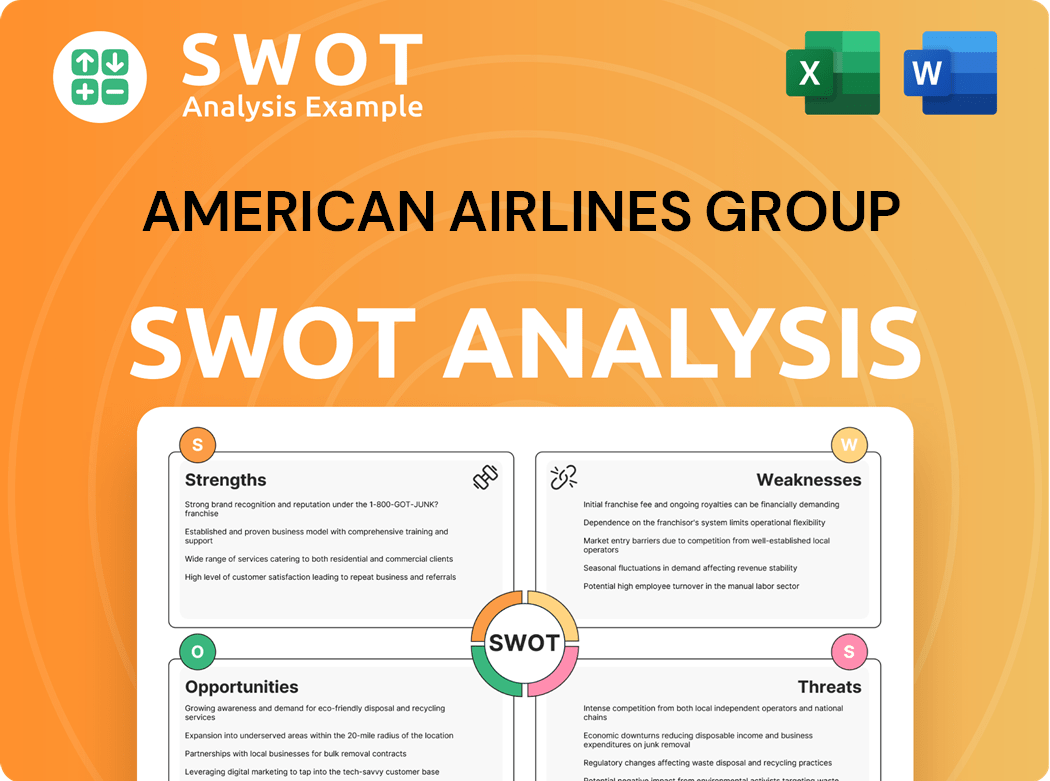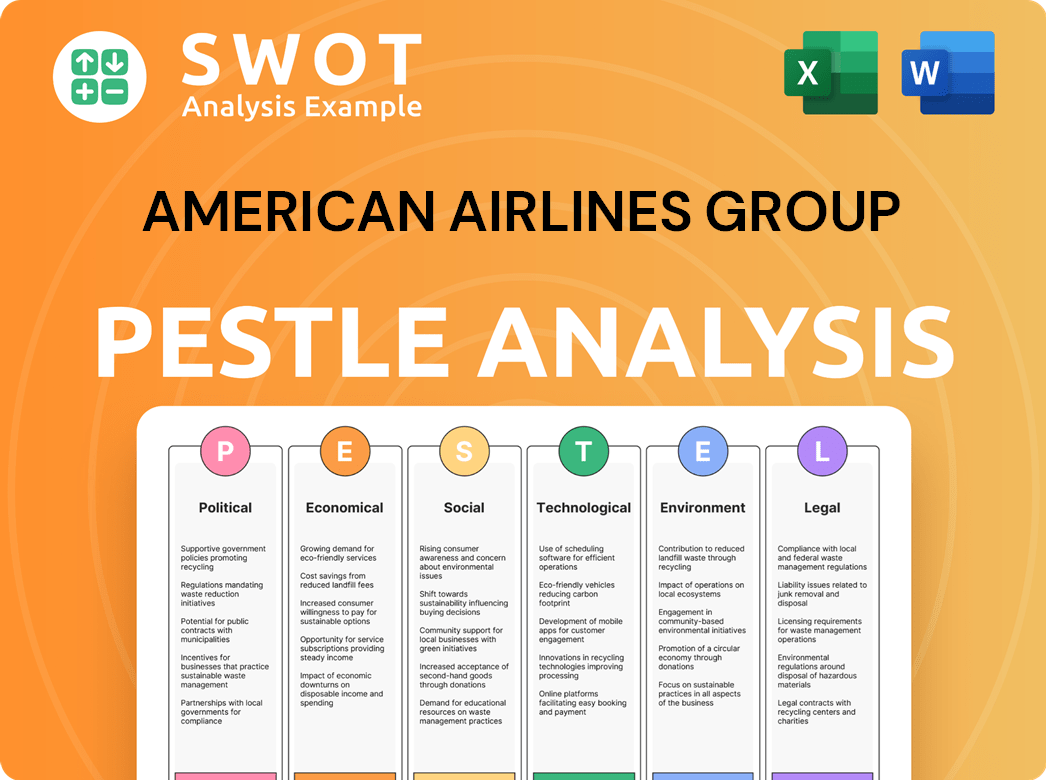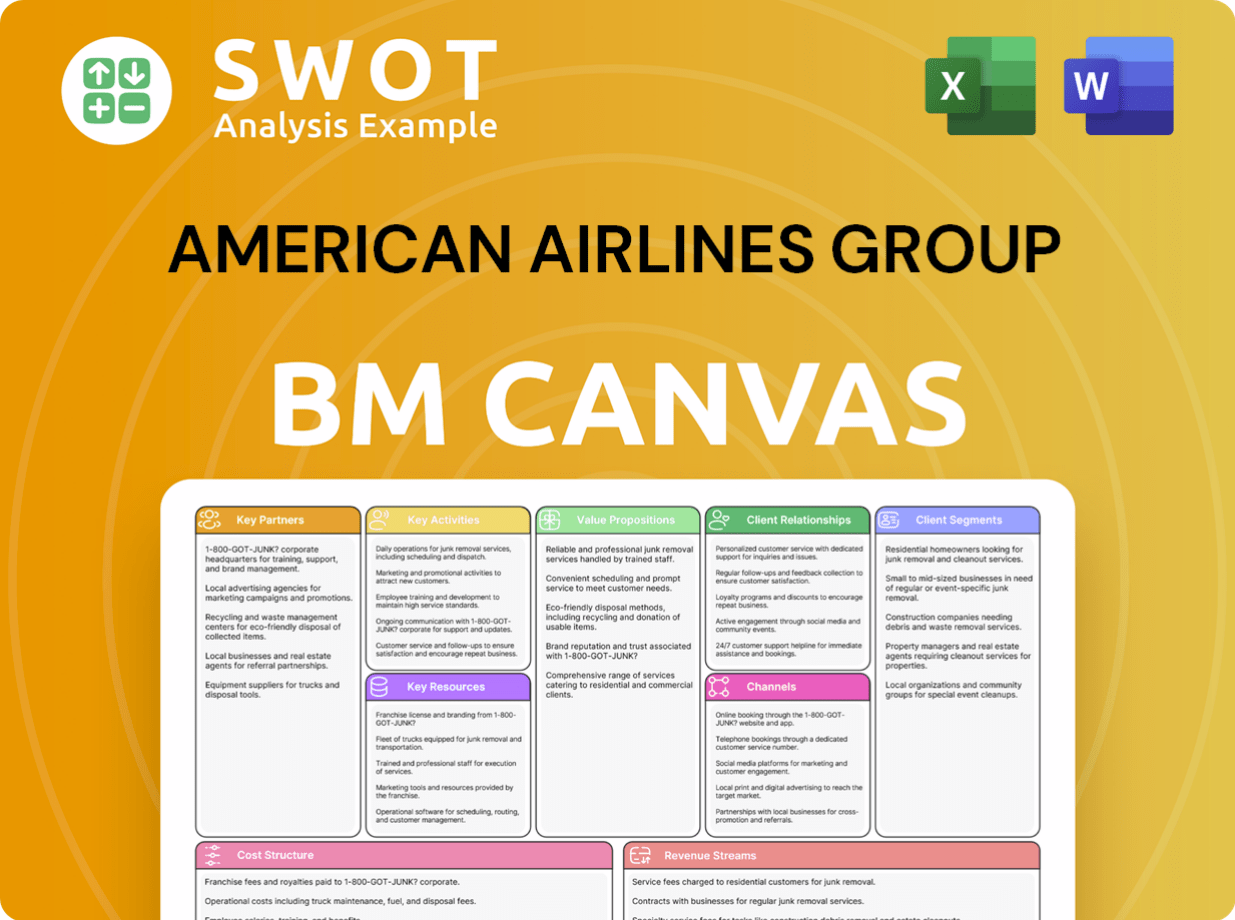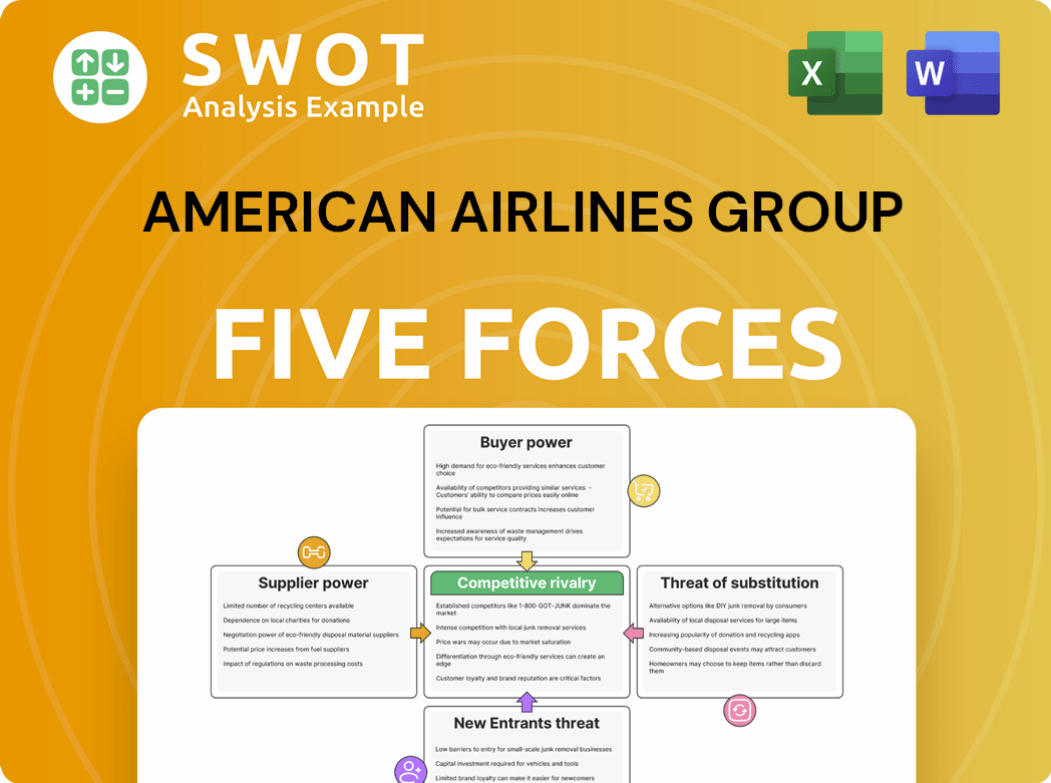American Airlines Group Bundle
Can American Airlines Soar to New Heights?
American Airlines Group, a titan in the global aviation arena, connects the world, but what's next for this industry leader? From its humble beginnings in the 1930s to its current status as a global powerhouse, American Airlines has consistently adapted to the ever-changing demands of the Airline Industry Analysis.

This deep dive into American Airlines Group SWOT Analysis will explore the company's strategic initiatives, expansion plans, and the potential impact of Aviation Market Trends on its future. We'll examine AAL Stock Performance, considering both opportunities and risks, to provide a comprehensive understanding of American Airlines' future prospects in a dynamic market. The analysis will also touch upon the competitive landscape and the company's sustainability goals.
How Is American Airlines Group Expanding Its Reach?
American Airlines Group (AAG) is actively pursuing expansion initiatives to bolster its global network and capitalize on emerging market opportunities. This strategic approach is crucial for sustaining growth and maintaining a competitive edge within the dynamic airline industry. These initiatives are designed to enhance its service offerings and broaden its market reach, which is essential for long-term success.
A key element of the American Airlines Growth Strategy involves expanding international routes, with a particular focus on Europe, Latin America, and the Caribbean. These strategic expansions are designed to cater to growing travel demands and strengthen the airline's presence in key global markets. This expansion is a vital component of the airline's strategy to diversify revenue streams and enhance its overall financial performance.
For summer 2025, American Airlines is set to debut five new routes to Europe, including nonstop flights to Edinburgh, Scotland, marking the first time since 2019. Additionally, new services will be launched to Athens, Greece, Madrid, Milan, and Rome. This expansion will see the airline offering over 70 daily flights between the U.S. and Europe by summer 2025. Furthermore, the airline is increasing its winter 2024-2025 high season schedule with eight new routes to Latin America and the Caribbean.
American Airlines is significantly expanding its route network. This includes new routes to Europe and Latin America, increasing flight frequency and destinations. The airline is focusing on high-demand routes to enhance its market share and revenue generation. These strategic moves are key to the company's long-term growth strategy.
The airline is enhancing its premium offerings to attract high-value customers. The introduction of Flagship Suite seats and premium cabin options on more flights is a key part of this strategy. These upgrades aim to improve customer experience and boost profitability. This approach aligns with the company's focus on customer satisfaction and revenue growth.
American Airlines is investing in fleet modernization to improve efficiency and reduce operational costs. This includes the introduction of new aircraft and upgrades to existing fleets. Fleet modernization is crucial for improving fuel efficiency and reducing environmental impact. This is a long-term investment strategy to enhance operational performance.
The airline is focused on improving the overall customer experience through various initiatives. This includes enhancements to in-flight entertainment, Wi-Fi, and other amenities. These initiatives are aimed at increasing customer satisfaction and loyalty. American Airlines is investing in customer service to drive long-term success.
Starting December 7, 2024, American Airlines will offer daily nonstop service from New York's John F. Kennedy International Airport (JFK) to St. Maarten's Princess Juliana International Airport (SXM). A Saturday-only service from Philadelphia will commence on November 9, 2024. New seasonal routes to Canada and the Rockies are also planned for summer 2025, connecting travelers to outdoor destinations such as Halifax, Quebec City, Calgary, Bozeman, and Kalispell. For more information on the company's values, consider reading about the Mission, Vision & Core Values of American Airlines Group.
American Airlines is enhancing its premium offerings and customer experience to stay competitive. The new Flagship Suite seats will debut on Boeing 787-9 aircraft starting June 5, 2025, featuring privacy doors and increased storage. These initiatives are designed to attract new customers and diversify revenue streams, ensuring the airline's competitiveness in the evolving aviation landscape.
- Flagship Suite seats on Boeing 787-9 aircraft starting June 5, 2025.
- Expansion of premium services to additional international routes throughout 2025.
- Premium cabin options on every flight from Chicago O'Hare International Airport (ORD) starting June 5, 2025.
- Focus on route network optimization and customer experience improvements.
American Airlines Group SWOT Analysis
- Complete SWOT Breakdown
- Fully Customizable
- Editable in Excel & Word
- Professional Formatting
- Investor-Ready Format

How Does American Airlines Group Invest in Innovation?
American Airlines Group (AAG) is strategically leveraging innovation and technology to fuel its growth strategy and enhance its future prospects. This approach focuses on fleet modernization, digital transformation, and improving the overall customer experience. These initiatives are designed to boost operational efficiency, reduce costs, and increase customer satisfaction, all of which are crucial for sustained growth in the competitive airline industry.
The company's commitment to these areas is evident in its significant investments in new aircraft, upgrades to in-flight services, and digital enhancements. These efforts are aimed at not only meeting current market demands but also positioning the airline for future challenges and opportunities within the aviation market.
For anyone interested in learning more about the company's structure, you can read about the Owners & Shareholders of American Airlines Group.
American Airlines is actively modernizing its fleet to improve efficiency and reduce environmental impact. This involves retiring older aircraft and integrating newer, more fuel-efficient models.
As of March 2025, American Airlines has a substantial order book, including 338 new jets. This includes 20 supersonic jets from Boom Aerospace, signaling a forward-thinking approach to air travel.
The average age of American Airlines' mainline fleet was 13.8 years as of December 2024. Modernization efforts aim to reduce this average, improving operational efficiency and reducing maintenance costs.
The new aircraft are designed to be more fuel-efficient, contributing to the airline's sustainability goals. This helps to lower operating costs and reduce the environmental footprint.
American Airlines is investing in digital technologies to enhance the customer experience and streamline operations. This includes improvements to in-flight Wi-Fi and other digital services.
The airline is focusing on improving the passenger experience through various upgrades, including premium seating options and enhanced in-flight amenities.
American Airlines is implementing several key initiatives to drive growth and improve customer satisfaction. These include:
- Free in-flight Wi-Fi rollout by 2026 to enhance connectivity and customer satisfaction.
- Introduction of Flagship Suite seats on new Boeing 787-9 aircraft, offering premium comfort and privacy.
- Installation of USB-C charging ports in economy on new aircraft to improve passenger convenience.
- Potential increase in 'Main Cabin Extra' seats and additional flight attendants on long-haul flights to enhance service.
American Airlines Group PESTLE Analysis
- Covers All 6 PESTLE Categories
- No Research Needed – Save Hours of Work
- Built by Experts, Trusted by Consultants
- Instant Download, Ready to Use
- 100% Editable, Fully Customizable

What Is American Airlines Group’s Growth Forecast?
The financial outlook for American Airlines in 2025 is marked by uncertainty. The company withdrew its full-year guidance due to economic volatility and other factors. The airline's performance in the first quarter of 2025 reflects these challenges, with a net loss reported.
American Airlines' Q1 2025 financial results, released on April 24, 2025, showed a net loss of $473 million on revenue of $12.6 billion. This loss is deeper than the $312 million loss in Q1 2024. Revenue for Q1 2025 decreased by 0.2% year-over-year, indicating a slight contraction in sales.
The company attributes these results to a decline in domestic leisure demand, economic uncertainty, and the impact of an accident. Despite these challenges, American Airlines provided a Q2 2025 forecast for adjusted earnings per diluted share, aiming for between $0.50 and $1.00.
American Airlines has provided a Q2 2025 forecast for adjusted earnings per diluted share, projecting earnings between $0.50 and $1.00. This guidance offers a glimpse into the company's expectations for the upcoming quarter. The forecast is a key indicator of the airline's financial health amidst market challenges.
By Q4 2024, American Airlines achieved its goal of reducing total debt by $15 billion from peak levels in mid-2021, a year ahead of schedule. At the start of 2025, the total debt stood at $36.6 billion. This debt reduction is a positive step in strengthening the airline's financial position.
In 2024, American Airlines generated a record free cash flow of $2.2 billion. This significant cash flow demonstrates the company's ability to generate strong returns. The strong cash flow is a crucial factor for the company's financial flexibility and investment capabilities.
American Airlines is focused on restoring revenue from indirect channels to historical levels by the end of 2025. This initiative aims to optimize revenue streams. The success of this strategy will be crucial for improving financial performance.
The airline's strategic focus includes cost management and balance sheet strengthening, reflecting a cautious approach to the volatile market. For further insights, consider exploring the Competitors Landscape of American Airlines Group.
American Airlines Group Business Model Canvas
- Complete 9-Block Business Model Canvas
- Effortlessly Communicate Your Business Strategy
- Investor-Ready BMC Format
- 100% Editable and Customizable
- Clear and Structured Layout

What Risks Could Slow American Airlines Group’s Growth?
American Airlines' growth strategy faces substantial risks and obstacles. Economic uncertainty and supply chain disruptions pose significant challenges to the airline's operational and financial performance. These factors, alongside labor relations and competitive pressures, could impact the company's ability to achieve its goals.
The airline industry is navigating a complex environment, with fluctuations in demand, rising operational costs, and the need for strategic adaptation. The challenges include economic volatility, supply chain bottlenecks, and the impact of fuel prices. Understanding these risks is crucial for assessing American Airlines' future prospects and its ability to maintain a competitive edge.
The airline's financial stability is at risk due to high debt, declining profitability, and a potential decline in airline demand. Refinancing risks appear high due to over $4 billion in current long-term debt maturities. These factors contribute to the need for careful management and strategic planning.
Economic uncertainty is a significant risk, leading to a decline in domestic leisure travel demand. This volatility is compounded by potential tariffs affecting fuel and aircraft part costs. Shifts in government spending can also reduce disposable income for travelers.
Supply chain issues, especially regarding aircraft and air traffic controller availability, are major problems. The industry experienced a shortfall in aircraft deliveries in 2024, with potential downward revisions for 2025. These disruptions impact revenues, costs, and environmental performance.
Ongoing contract negotiations and potential disputes pose risks. While a contract extension with ground workers was ratified in late 2024, the broader labor landscape remains a factor. Operational interruptions on key routes could arise from labor issues.
Intense market competition, high debt levels, and vulnerability to fuel price fluctuations are ongoing concerns. These factors could impact profitability and financial stability. The competitive landscape requires continuous strategic adjustments to maintain market share.
The company's financial stability is at risk due to high debt, declining profitability, and a potential decline in airline demand. Refinancing risks are high due to over $4 billion in current long-term debt maturities. These financial pressures demand careful management.
Fluctuations in fuel prices can significantly impact operating costs. The airline industry is highly sensitive to these changes, which can affect profitability and financial planning. Managing fuel costs is a critical aspect of financial strategy.
Analyzing the AAL stock performance provides insights into investor confidence and market perception. Key metrics include stock price fluctuations, trading volume, and market capitalization. Reviewing historical data helps to understand the impact of various factors on the stock's value.
Understanding aviation market trends is essential for strategic planning. This includes analyzing passenger traffic forecasts, cargo business outlook, and route network optimization. Marketing Strategy of American Airlines Group is influenced by these trends.
Fuel prices significantly impact operational costs and profitability. Fluctuations in fuel prices require careful financial planning and hedging strategies. Monitoring fuel costs is critical for managing expenses and maintaining financial stability.
The competitive landscape includes major airlines and low-cost carriers. Analyzing the competitive environment helps to identify market share dynamics and strategic positioning. Understanding the competitive landscape is crucial for strategic decision-making.
American Airlines Group Porter's Five Forces Analysis
- Covers All 5 Competitive Forces in Detail
- Structured for Consultants, Students, and Founders
- 100% Editable in Microsoft Word & Excel
- Instant Digital Download – Use Immediately
- Compatible with Mac & PC – Fully Unlocked

Related Blogs
- What are Mission Vision & Core Values of American Airlines Group Company?
- What is Competitive Landscape of American Airlines Group Company?
- How Does American Airlines Group Company Work?
- What is Sales and Marketing Strategy of American Airlines Group Company?
- What is Brief History of American Airlines Group Company?
- Who Owns American Airlines Group Company?
- What is Customer Demographics and Target Market of American Airlines Group Company?
Disclaimer
All information, articles, and product details provided on this website are for general informational and educational purposes only. We do not claim any ownership over, nor do we intend to infringe upon, any trademarks, copyrights, logos, brand names, or other intellectual property mentioned or depicted on this site. Such intellectual property remains the property of its respective owners, and any references here are made solely for identification or informational purposes, without implying any affiliation, endorsement, or partnership.
We make no representations or warranties, express or implied, regarding the accuracy, completeness, or suitability of any content or products presented. Nothing on this website should be construed as legal, tax, investment, financial, medical, or other professional advice. In addition, no part of this site—including articles or product references—constitutes a solicitation, recommendation, endorsement, advertisement, or offer to buy or sell any securities, franchises, or other financial instruments, particularly in jurisdictions where such activity would be unlawful.
All content is of a general nature and may not address the specific circumstances of any individual or entity. It is not a substitute for professional advice or services. Any actions you take based on the information provided here are strictly at your own risk. You accept full responsibility for any decisions or outcomes arising from your use of this website and agree to release us from any liability in connection with your use of, or reliance upon, the content or products found herein.